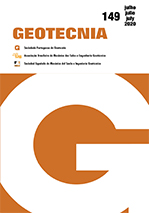Influence of surface erosions and cracks in tailings dams safety
DOI:
https://doi.org/10.24849/j.geot.2020.149.05Keywords:
Safety of dams, portfolio analysis, anomaliesAbstract
The increasing number of ruptures of tailings dams imposes constant advances in the techniques of safety assessment of these structures. Portfolio analysis is considered the most agile assessment technique in the safety assurance routine; however, its application is often subjective and dependent on the evaluator's expertise. In this sense, this article presents the results of the evaluation of the influence of erosions and cracks on the safety of tailings dams aiming at the decrease of subjectivity in portfolio analysis. Five typical dams, both upstream and downstream raised, were simulated with varying strength parameters of the landfill and tailings, totalling a universe of 90 dams. Surface erosions and cracks of small, medium and large magnitudes were simulated as well as the combined effect of these anomalies. The results indicated the loss of safety margin for erosions of 3.5%, 7.0% and 10.5% and for cracks of 8%, 16% and 24%. The results for the combined simulations revealed that the overlap of effects can be approximated by the simple sum of the loss of safety margin of the anomalies ascertained. It is concluded that the field anomaly survey technique for evaluating the impact on the safety of tailings dams is valid, indicating that it is possible to apply the portfolio analysis with less subjectivity of the evaluator. It is also concluded that this technique can be expanded and contribute to frequent evaluations and safety assurance of tailings dams.
Downloads
References
ANA – Agência Nacional de Águas (2017). Relatório de segurança de barragens 2016. ANA, Brasília, 225 p.
Bowles, D.S.; Anderson, L.R.; Glover, T.F.; Chauhan, S.S. (1999). Understanding and managing the risk of aging dams: principals and case studies. In: 19th USCOLD Annual Meeting and Lecture, Atlanta, USA.
Bowles, D.S. (2000). Advances in the practice and use of portfolio risk assessment. In: Proceedings of the 2000 Australian Committee on Large Dams – ANCOLD, pp. 1-12, Queensland, Australia.
Brasil (2010). Política Nacional de Segurança de Barragens, Lei no. 12.334, de 20 de setembro de 2010. Casa Civil – Subchefia para Assuntos Jurídicos, Brazil.
Curt, C.; Talon, A.; Mauris, G. (2011). A dam assessment support system based on physical measurements, sensory evaluations and expert judgements. Measurement, 44 (1): 192-201.
Duncan, J.M. (1996). State of the Art: Limit Equilibrium and Finite-Element Analysis of Slopes. Journal of Geotechnical Engineering, 122 (1): 577-596.
Fell, R.; Bowles, D.S.; Anderson L.R.; Bel, G. (2000). The status of methods for estimation of the probability of failure of dams for use in quantitative risk assessment. In: Proceedings of 20th International Congress on Large Dams, Beijing, China
Hariri-Ardebili, M.A. (2018). Risk, Reliability, Resilience (R3) and beyond in dam engineering: A state-of-the-art review. International Journal of Disaster Risk Reduction, 31 (1): 806-831.
Hartford, D.N.D.; Baecher, G.B. (2004). Risk and uncertainty in dam safety. Thomas Telford Ltd, London. 391 p.
ICOLD – International Commission on Large Dams (1982). Manual on Tailings Dams and Dumps. Committee on Dam Safety, Bulletin 45, Paris.
ICOLD – International Commission on Large Dams (1989). Tailings Dam Safety. Committee on Dam Safety, Bulletin 97, Paris.
ICOLD – International Commission on Large Dams (2005). Risk assessment in dam safety management: a reconnaissance of benefits, methods and current applications. Committee on Dam Safety, Bulletin 130, Paris.
ICOLD – International Commission on Large Dams (2009). Dam safety management. In: Proceedings of 23rd International Congress on Large Dams, Brasília, Brazil.
Jansen, R.B. (1983). Dams and Public Safety. US Government Printing Office, US Bureau of Reclamation, Denver, 332 p.
Jeon, J.; Lee, J.; Shin, D.; Park, H. (2009). Development of dam safety management system. Advances in Engineering Software, 40 (1): 554-563.
Morgenstern, N.R. (2018). Geotechnical Risk, Regulation, and Public Policy. Soils and Rocks, 41(2): 107-129.
Schultz, M.T. Gouldby, B.P.; Simm,J.D.; Wibowo, J.L. (2010). Beyond the factor of safety: Developing fragility curves to characterize system reliability. Techical Report: ERDC SR 10-1. U.S. Army Corps of Engineers, Washington.
Silva, F. Lambe, T.W. Marr, W.A. (2008). Probability and risk of slope failure. Journal of Geotechnical Environmental Engineering, 134 (12): 1691-1699.
USACE – United States Army Corps of Engineers (1992). Guidelines for risk and uncertainty analysis in water resources planning, v. 2. IWR Report 92-R-2. U.S. Army Corps of Engineers, Washington.
Valenzuela, L. (2016). Design, construction, operation and the effect of fines content and permeability on the seismic performance of tailings sand dams in Chile. Obras y Proyectos, 19 (1): 6-22.
Zhang, L.; Peng, M.; Chang D.; Xu Y. (2016). Dam failure mechanisms and risk assessment. John Wiley & Sons, Singapore, 476 p.





